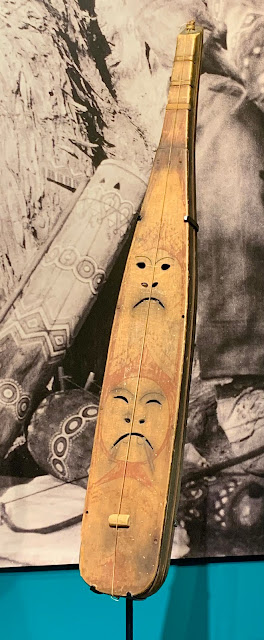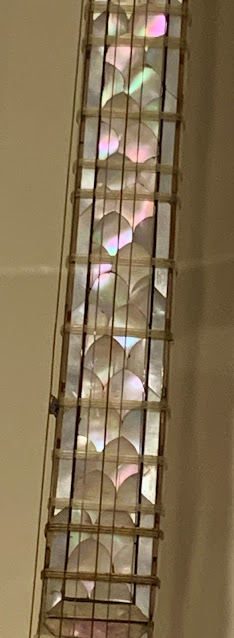Let's get started!
 |
In the Target Gallery to see the Treasures: Legendary Musical Instruments exhibit.
|
 |
"Zendegi" kamancheh, a bowed spike lute from Iran, 1750-1794. Made from mulberry, rosewood, apricot, and fufel woods with camel bone, silver, and fish skin.
|
 |
This long, thin ceremonial trumpet may not look like much, but it's a salpinx made of bone and bronze and is about 2,300 years old. It may very well have been played at one of the original Olympic Games to introduce the athletes.
|
 |
This Chinese paigu (goblet drum) is 6,000 years old and is the oldest instrument in MIM's collection.
|
 |
A Mayan conch shell trumpet made from shell and cinnabar. It dates from 250-400 AD.
|
 |
A sitār from northern India made in the early 1899s of wood, calabash, bone, and brass.
|
 |
Sitār detail. The detail on some of these instruments simply blows me away.
|
 |
The exhibit on Native American instruments.
|
 |
An Apache fiddle from Arizona. Made in the early 1900s of agave plant, horsehair, and pigment.
|
 |
A kelutviaq (bowed lute) made by the Yup'ik people of Alaska in the late 1800s of wood and pigment.
|
 |
This pochette (pocket fiddle) was made in Paris, France, in 1671 of ebony, boxwood, and silver wire. It was a status symbol used by dance masters to teach dance steps to aristocrats and was made to fit in the master's large pocket.
|
 |
A Kumu model ukulele made in Honolulu, Hawaii, in 2021. Koa wood, mahogany, ebony, mother-of-pearl, abalone, reconstituted stone, turquoise, onyx. The shimmering abalone shell framing the koa wood body symbolizes the ocean surrounding the islands, and the fingerboard inlays depict a coral reef complete with red kumu fish. This instrument is GORGEOUS.
|
 |
Detail of ukulele fingerboard.
|
 |
Khatam tonbak (goblet drum) from Iran made from mulberry and rosewood, animal skin, camel bone, and brass.
|
 |
This Ottoman tanbur (plucked lute) was made in Turkey in the early to mid-1700s of wood, mother-of-pearl, tortoiseshell, gold leaf, and ivory.
|
 |
Tanbur detail.
|
 |
Tanbur detail. This tanbur and the ukulele were my two favorites in the exhibit. You should see how they both glow in the lighting!
|
 |
Harp made by the Mangbetu people of the Democratic Republic of the Congo, 1875-1900, of wood, fiber, brass tack, copper, and goatskin. The harp was a praise-singer's instrument, played to elevate the status claims of important individuals.
|
 |
A bell made by the Mangbetu people of the Democratic Republic of the Congo. It was ceremonially sounded to accentuate a chief's speech or actions.
|
Now... if we could only hear all of these instruments being played!



















Those instruments are amazing, Cathy. And it just goes to show you how important music is in people's lives. To me, it's universal. I'm amazed just thinking of that 6,000-yaer-old drum, and what it must have been like to hear it back when it was made. Instruments are such windows on their worlds.
ReplyDeleteYes, they are. It's amazing to me when I think that humans have felt the need for music for thousands of years. What encouraged the first human to make music? Was it listening to a bird sing or wolves howl? We'll never know, but I'd hate to think of a world without music.
DeleteYes, I find it amazing that peoples around the world and in all different levels of development, and with different materials, were able to create instruments and music, as well as to craft art. It humbles me.
ReplyDeleteYes!
DeleteI think the proper word is that I'm in awe. And who knew? Until you posted your photos of this museum's exhibits, we would have missed out on knowing about these instruments.
DeleteLooking at the photos a second time, I want everyone to know about this exhibit.
And just think: the instruments I shared in this post are only a few from the entire exhibit.
DeleteWow. I'm surprised more people don't know about this fabulous museum. I'm sending my bro-in-law this link. He plays the violin and might be interested.
ReplyDeleteIt's one of the top attractions in the area, and it's not just Phoenicians who are visiting, so it's well known in some circles.
Delete